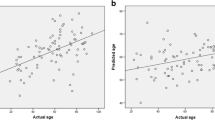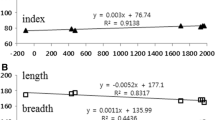Abstract
This study examined the three-dimensional (3D) changes in craniofacial morphology between 482 identified Portuguese skulls from the eighteenth to the twentieth centuries and 150 modern Portuguese individuals randomly selected from the armed forces. The goal was to investigate the interrelationship between changes in various parts of the skull, in particular, the cranial base, the brain supporting structures, and the face. Cone beam computed tomography images from the identified skull collections belonging to the Department of Life Sciences at the University of Coimbra and Natural History National Museum of Lisbon were used. These 3D images from craniometric analyses included 19 different linear, angular, and orthogonal 3D measurements. The trend in horizontal position of the maxilla (SNA) and horizontal position of the mandible (SNB) angles showed a significant increase, while the relative position of the maxilla to mandible (ANB) and the global angle mean values decreased over time. Skulls from each subsequent century demonstrated a decrease in anterior cranial base, indicated by the mean distance between S and N landmarks. Significant negative correlations were found between SNA and anterior cranial base length (S-N). The negative correlations between SNB and anterior cranial base length (S-N) decreased from the eighteenth to nineteenth centuries. The twenty-first century skulls were characterized by a significant difference in the mean value of different craniofacial variables between males and females. The results of this study suggest changes in the 3D cephalometric measurements of craniofacial architecture. These changes are highly integrated, and show an interesting correlation between structures of the craniofacial facial complex and the anterior cranial base.












Similar content being viewed by others
References
Adam GL, Gansky SA, Miller AJ, Harrel WE Jr, Hatcher DC. Comparison between traditional 2-dimensional cephalometry and a 3-dimensional approach on human dry skulls. Am J Orthod Dentofacial Orthop. 2004;126:397–409.
Anderson D, Popovich F. Lower cranial base height versus cranial facial dimensions in angle class II malocclusion. Angle Orthod. 1983;53:253–60.
Angel JL. Colonial to modern skeletal change in United States. Am J Phys Anthropol. 1976;45:723–36.
Angel JL. A new measure of growth efficiency-skull base height. Am J Phys Anthropol. 1982;58:297–305.
Basili C, Otsuka T, Kubota M, Slavicek R, Sato S. Three-dimensional CT analysis of vomer bone in the architecture of craniofacial structures in caucasic human skulls. Int J Stomatol Occl Med. 2009;2:191–204.
Bastir M, Godoy P, Rosas A. Common features of sexual dimorphism in the cranial airways of different human populations. Am J Phys Anthropol. 2011;146:414–22.
Bastir M, Rosas A. Hierarchical nature of morphological integration and modularity in the human posterior face. Am J Phys Anthropol. 2005;128:26–34.
Bastir M, Rosas A, Lieberman DE, O’Higgins P. Middle cranial fossa anatomy and the origin of modern humans. Anat Rec. 2008;291:130–40.
Birmingham D. A concise history of Portugal. Cambridge:Cambridge University Press; 1993.
Bjork A. Cranial base development: a follow-up x-ray study of the individual variation in growth occurring between the ages of 12 and 20 years and its relation to brain case and face development. Am J Orthod. 1955;41:198–225.
Boas F. Changes in bodily form of descendents of immigrants. Am Anthropol. 1912;14:530–63.
Brown AA, Scarfe WC, Scheetz JP, Silveira A, Farman AG. Linear accuracy of cone beam CT derived 3D images. Angle Orthod. 2009;79:150–7.
Buretic-Tomljanovic A, Giacometti J, Ostojic S, Kapovic M. Sex-specific differences of craniofacial traits in Croatia: the impact of environment in a small geographic area. Ann Hum Biol. 2007;34:296–314.
Buretic-Tomljanovic A, Ostojic S, Kapovic M. Secular change of craniofacial measures in Croatian younger adults. Am J Hum Biol. 2006;18:668–75.
Cameron N, Tobias PV, Fraser WJ, Nagdee M. Search for secular trends in calvarial diameters, cranial base height, indexes, and capacity in South African Negro crania. Am J Hum Biol. 1990;2:53–61.
Costa HN, Slavicek R, Sato S A computerized tomography study of the morphological interrelationship between the temporal bones and the craniofacial complex. J Anat. 2012 220:544–54. doi:10.1111/j.1469-7580.2012.01499.x.
Cunha E, Wasterlain S. The Coimbra identified skeletal collections. In: Grupe G, Peters J, editors. Documenta Archaeobiologiae (Vol 5). Skeletal series and their socio-economic context. Rahden/Westf:Maria Leidorf; 2007. pp. 23–34.
Dhopatkar A, Bathia S, Rock P. An investigation into the relationship between the cranial base angle and malocclusion. Angle Orthod. 2002;72:456–63.
Enlow DH, McNamara JA. The neurocranial basis for facial form and pattern. Angle Orthod. 1973;43:256–70.
Hayashi K, Saitoh S, Mizoguchi I. Morphological analysis of the skeletal remains of Japanese females from the Ikenohata-Shichikencho site. Eur J Orthod. 2011;34:575–81.
Jantz RL. Cranial change in Americans: 1850–1975. J Forensic Sci. 2001;46:784–7.
Jantz RL, Meadows Jantz L. Secular change in craniofacial morphology. Am J Hum Biol. 2000;12:327–38.
Jonke E, Prossinger H, Bookstein FL, Schaefer K, Bernhard M, Freudenthaler JW. Secular trends in the facial skull from the 19th century to the present, analyzed with geometric morphometrics. Am J Orthod Dentofacial Orthop. 2007;132:63–70.
Kerr WJ, Adams CP. Cranial base and jaw relationships. Am J Anthrop. 1988;77:213–20.
Komar DA, Grivas C. Manufactured populations: what do contemporary reference skeletal collections represent? A comparative study using the Maxwell Museum documented collection. Am J Phys Anthropol. 2008;137:224–33.
Komlos J. Stature, living standards, and economic development: essays in anthropometric history. Chicago:University of Chicago Press; 1994.
Kouchi M. Brachycephalization in Japan has ceased. Am J Phys Anthropol. 2000;112:339–47.
Lagravere M, Carey J, Toogood R, Major PW. Three dimensional accuracy of measurements made with software on cone beam computed tomography images. Am J Orthod Dentofacial Orthop. 2008;134:112–6.
Lieberman DE, Ross CF, Ravosa MJ. The primate cranial base: ontogeny. Function and integration. Am J Phys Anthropol. 2000;113:117–69.
Little BB, Buschang PH, Reyes ME, Tan SK, Malina RM. Craniofacial dimensions in children in rural Oaxaca, southern Mexico: secular change, 1968–2000. Am J Phys Anthropol. 2006;131:127–36.
Muramatsu A, Nawa H, Kimura M, Yoshida K, Maeda M, Katsumata A, Ariji E, Goto S. Reproducibility of maxillofacial anatomic landmarks on 3-dimensional computed tomographic images determined with the 95 % confidence ellipse method. Angle Orthod. 2008;78:396–402.
Periago DR, Scarfe WC, Moshiri M, Scheetz JP, Silveira AM, Farman AG. Linear accuracy and reliability of cone beam CT derived 3-dimensional images constructed using an orthodontic volumetric rendering program. Angle Orthod. 2008;78:387–95.
Plavcan JM. Understanding dimorphism as a function of changes in male and female traits. Evol Anthropol. 2011;20:143–55.
Polat OO, Kaya B. Changes in cranial base morphology in different malocclusions. Orthod Craniofacial Res. 2007;10:216–21.
Relethford JH. Apportionment of global human genetic diversity based on craniometrics and skin color. Am J Phys Anthropol. 2002;118:393–8.
Sato S. The dynamic functional anatomy of craniofacial complex and its relation to the articulation of the dentitions. In: Slavicek R, editor. The masticatory organ: functions and dysfunctions. Klosterneuburg: GAMMA Medizinisch-wissenschafttliche Fortbildungs-AG. 2002. pp. 482–515.
Sjovold T. Testing assumptions for skeletal studies by means of identified skulls from Hallstatt. In: Sauders SR, Herring A, editors. Grave reflections: portraying the past through cemetery studies. Toronto:Canadian Scholars’ Press; 1995. pp. 241–81.
Slavicek R. The masticatory organ. Austria:Gamma Medizinisch-Wissenschaftliche Fortbildungs-AG; 2002.
Spradley MK. Biological anthropological aspects of the African Diaspora: geographic origins, secular trends, and plastic versus genetic influences utilizing craniometric data (Dissertation). Knoxville: University of Tennessee; 2006.
Swennen GR, Schutyser F, Barth EL, De Groeve P, De Mey A. A new method of 3-D cephalometry. Part I: the anatomic Cartesian 3-D reference system. J Craniofac Surg. 2006;17:314–25.
Tomislav L. 3D diagnostics in orofacial region. Rad 514 Medical Sciences. 2012;38:127–52.
Van Vlijmen OJ, Berge SJ, Swennen GR. Comparison of cephalometric radiographs obtained from cone-beam computed tomography scans and conventional radiographs. J Oral Maxillofac Surg. 2009;67:92–7.
Varella J. Early development traits in class II malocclusion. Acta Odontol Scand. 1998;56:375–7.
Wescott DJ, Jantz RL. Assessing craniofacial secular changes in American blacks and whites using geometric morphometry. In: Slice DE, editor. Modern morphometrics in physical anthropology. New York: Kluwer Academic. 2005. pp. 231–45.
Wiesensee KE, Jantz RL. Secular changes in craniofacial morphology of the Portuguese using geometric morphometrics. Am J Phys Anthropol. 2011;145:548–59.
Acknowledgments
This work was performed at the Research Institute of Occlusion Medicine and the Research Centre of Brain and Oral Science, Kanagawa Dental College, and was supported by a grant-in-aid for Open Research from SICAT GmbH & Co. Germany. The authors would like to express their gratitude to the Ludwig-Slavicek Foundation, to the Department of Life Sciences at University of Coimbra Portugal, to Professor H. Cardoso (Natural History Museum of Lisbon), to the postgraduate students (skull project) involved in the data collection process, especially M. Tanaka, O. Takeda, and S. Kishimoto, and to the members of the orthodontic department and to Professors J. Freitas and L. Lourenço.
Conflict of interest
The authors declare that there are no actual or potential conflicts of interest in relation to this article.
Author information
Authors and Affiliations
Corresponding author
Rights and permissions
About this article
Cite this article
Alves Proença, H., Slavicek, R., Cunha, E. et al. A 3D computerized tomography study of changes in craniofacial morphology of Portuguese skulls from the eighteenth century to the present. J. Stomat. Occ. Med. 7, 33–45 (2014). https://doi.org/10.1007/s12548-014-0105-3
Received:
Accepted:
Published:
Issue Date:
DOI: https://doi.org/10.1007/s12548-014-0105-3




